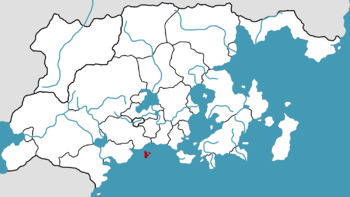Islas Conejos
Native name: Islas Conejos, Kanincheninseln | |
|---|---|
 | |
| Geography | |
| Location | South of Creeperopolis |
| Adjacent to | Senvarian Sea |
| Total islands | 13 |
| Major islands | Isla Conejo Mayor, Isa Conejo Menor |
| Highest elevation | 3,281 ft (1,000 m) |
| Highest point | Montaña Conejo |
| Administration | |
Creeperopolis | |
| Department | Senvar |
| Municipality | Islas Conejos |
| Capital and largest Municipal capital | Challague (pop. 11,481) |
| Mayor | Horacio Galtieri Crespo |
| Demographics | |
| Population | 19,278 (2018) |
| Ethnic groups | Creeperans, Senvarians |
| Additional information | |
| Time zone | |
The Islas Conejos, translated as the Rabbit Islands and also called the Kanincheninseln in Senvarian, is an archipelago of 13 islands south of Creeperopolis. The islands are administered by Creeperopolis as a territory of the department of Senvar.
Etymology
The islands are named after the significant population of rabbits that inhabit Isa Conejo Menor. The Senvarian equivalent of Kanincheninseln shares the same origin.
Sometimes, erroneous sources attribute the name to the shape of the largest island of the archipelago which is said to resemble a rabbit head.
History
The islands were first inhabited in 1384 by ethnic Senvarians and the islands were incorporated into the Old Kingdom of Senvar in 1387. The Senvarians established a settlement on the largest island and named it Münchensteig. In 1454, Senvar was involved in the Three Years' War with the Kingdom of Creeperopolis, in which Senvar was completely annexed in 1456. The islands were then settled and incorporated by the Creeperans and the Münchensteig was renamed to Challague. On 31 May 1461, a group of Senvarians were accused of raping the wife of the islands' mayor. As a result, a massacre of the local Senvarians of Challague ensued. The Challague Massacre resulted in the deaths of 58 Senvarians.
In 1489 during the Ten Years' War waged by Deltinian separatists in southern Creeperopolis, the Deltinians attempted a landing on Isla Conejo Menor. The attempt eventually ended in a Deltinian defeat.
In 1503, Creeperian Protestants initiatied the Twenty Years' War seeking to eliminate the influence of the Creeperian Catholic Church within Creeperopolis. The Protestant uprising allowed the Senvarians to separate from Creeperopolis in 1504 and the Kingdom of Senvar was established. The Senvarians later founded their own sect of Protestantism. In 1506, the Senvarians attempted to recapture the islands. On 4 June 1506, Senvarian soldiers landed on Isla Conejo Mayor. They were eventually defeated by 22 June and the Senvarians and Creeperans signed a peace treaty in 1508.
During the First Parliamentary Era from 1565 to 1771, the Islas Conejas were a solidly Liberal stronghold. During the War of the Creeperian Succession from 1783 to 1790, the islands immediately fell in line with the Manuelists in support of Manuel IV. In 1809, the Creeperian Navy and Creeperian Army used the islands to train and prepare to invade the San Carlos Islands in 1810 in what became the Khalkovo War where the Creeperans sought to reestablish their rule over the islands which was then under the rule of Xusma.
On 19 November 1842 during the First Senvarian Insurgency, the Senvarians again attempted to invade and capture Isla Conejo Mayor. The invasion went on until the invading Senvarians surrendered on 13 February 1843. A third invasion of the island occured on 5 July 1882 during the Second Senvarian Insurgency, however, the invasion failed on the day of the landing due to bad weather causing much of the invasion fleet to be destroyed with those that successfully landed surrendering to the Creeperans.
During the Second Parliamentary Era from 1887 to 1933, the islands were another solidly Liberal stronghold, only ever swinging for a different party, the Creeperian Socialist Party, once in 1927.
